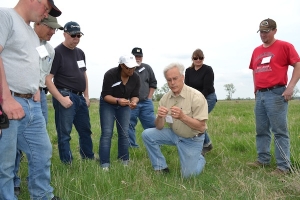Long term sustainability of our soil requires farming systems that can not only keep soil in place, but also help it build its own resiliency. Such systems can’t just work on paper—they need to prove themselves agronomically and financially. And they need to prove it in places like western Minnesota’s Redwood County, a place where the Minnesota River bisects mostly corn and soybean fields.
At a recent Land Stewardship Project Farm Beginnings field day, a grass-based production system was proving it could pull its own weight financially and practically, and then some.
“Before, this field would make a crop maybe three years out of 10,” said Grant Breitkreutz, who along with his wife Dawn and 14-year-old daughter Karlie, hosted the field day on their Redwood County farm. “We’re grazing it three times a year now.” (Grant and Dawn Breitkreutz talk on LSP’s Ear to the Ground podcast about how their grazing system is improving the economic and environmental health of their farm.)

The Breitkreutzes began rotational grazing 10 years ago and liked it. The cattle and the pastures were healthier, and it reduced their reliance on raising crops for feed. Three years ago they cranked it up a notch and dived into mob grazing, also called short-duration, high-density grazing. As its name implies, a large number of cattle are turned out into a grazing paddock for a short—sometimes just a day—period of time. They get a chance to browse the grass but are moved quickly enough that they don’t eat it all. In fact, a fair amount of the forage is trampled into the soil, helping build the biological activity so key to creating viable, drought-proof pastures that particular season, as well as for years to come, according to Howard Moechnig, a Cannon Falls, Minn.-based grazing consultant who led a workshop during the field day.
“Sometimes people think if you start rotational grazing, you can automatically double your stocking rate,” Moechnig explained to the two dozen beginning farmers and others that attended the workshop. “But you’re not out there to take all that grass off that pasture. You’re there to match the animals to the feed available and to leave some grass behind. You need to make it so the life in the soil can do its job.”
The Breitkreutzes have been able to get excellent forage production even in drought years like 2012—quite an accomplishment considering that much of their farm consists of a light soil type that tends to dry out easily. They feel the mob grazing system is building the kind of soil that can make better use of available moisture, something that farmers and soil conservationists working in Burleigh County, N. Dak., can confirm.
Their cow-calf herd is thriving, weeds are easier to control and their input costs are down. The Breitkreutz farm’s increased productivity is striking. On their home place, 58 cow-calf pairs was about all the farm could handle just a few years ago. Last year, they ran 125 pairs during a very dry growing season. The result: a more robust bottom line.
“Absolutely it’s better financially. Some people think that’s too much work to move the cows every day,” said Dawn. “But when you look at the bottom line and what our inputs are and what we have at the end of the year, it’s so much more worth it.”
The financial benefits can show themselves in a dozen different ways. For example, the family estimates it was costing them 400 gallons of diesel fuel annually to haul manure when the cattle were penned up for a good part of the year. Now, with more than twice the number of animals, they burn roughly 25 percent less fuel hauling hay out to them during the non-grazing system.
“That’s a pretty good tradeoff,” said Moechnig.
And the land is starting to respond to all that biological activity in a way that makes it self-perpetuating. At one point during the tour, Moechnig kneeled down in a grazing paddock and counted five species of perennial forages. Grant said not only did the family not plant those species, but for years they were using thistle-killing herbicides that were also detrimental to beneficial grasses and forbs. Now, mob grazing is controlling the thistles better while helping pastures undertake a form of homegrown regeneration.
“When you’re managing for maximum grass production and multi-species, everything else just comes with it,” said Grant. “The ground will produce on its own through the use of livestock.”
And there are signs that this grazing system is having a positive impact on a landscape-wide basis. A 680-acre wildlife management area controlled by the Minnesota Department of Natural Resources (DNR) runs along the nearby Minnesota River and borders the Breitkreutz farm. The family has a “cooperative farming agreement” with the DNR where they help manage the state land by grazing their cattle herd there periodically.
“The wildlife management officer that takes care of our area was seeing what we’re doing with our own pastures and just said, ‘Do that with our land,’ ” said Grant.
“We’re seeing birds we’ve never seen here,” said Dawn as bobolinks, a highly grass-dependent species, fluttered around in a grazing paddock, flashing their trademark black-and-white markings. “Everything wants to be here, and we see that as a definite positive.”
By everything wanting to be present on the farm, one could include the Breitkreutzes’ daughter, Karlie. She’s quite active in the operation, and has expressed a firm commitment to continue its legacy of balancing stewardship and food production.
“The whole idea of this is it’s supposed to be fun and profitable,” said Grant after the field day. “So that’s what we’re trying to do is make it fun and profitable so the kids want to stay and keep going and doing what we’re doing.”